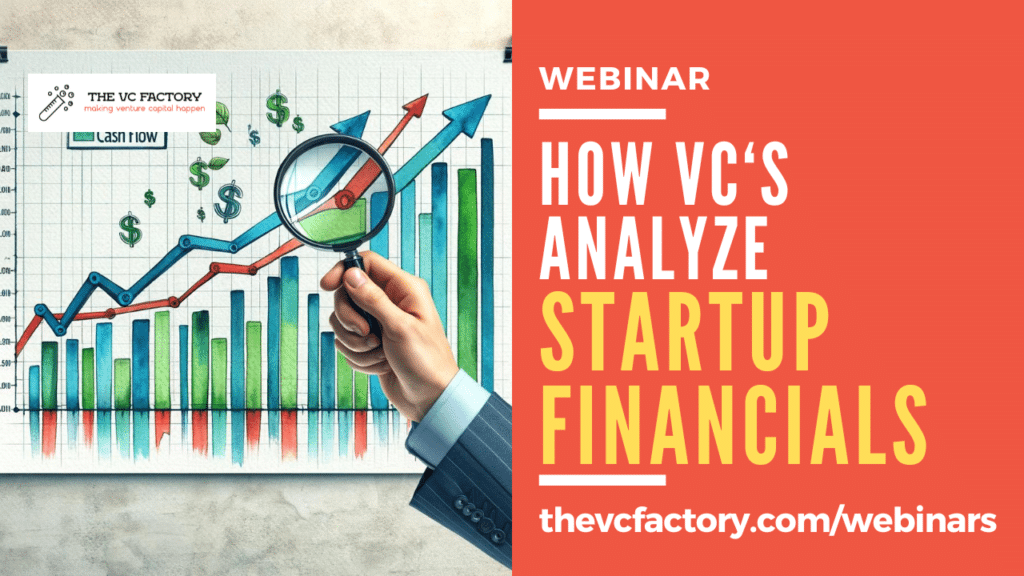How Experienced Venture Capitalists Analyze Startup Financials
- 2.6K views
- 19 minute read

Creating startup financials is, despite claims to the contrary, an essential part of the fundraising process. Solid financial projections based on verifiable data serve both entrepreneurs and Venture Capitalists analyzing the startup's viability. Experienced VCs know that startups don't make their plan; they use the forecast as a basis for a larger conversation on the startup's business model and growth plan, as well as the Founders' vision. In this article and its companion webinar, I explain why it makes sense to build startup financials and how VCs analyze them to run sensitivity scenarios. I also included a short but sweet "Finance 101" section on startup financials.
In This Article
- Why Venture Capitalists Require Startup Financials
- Startup Financials: What You Need To Know
- The Optimal Startup Financials Package For VC Investors
- Additional Data: Visualizing Cash Needs
- How VCs Use Startup Financials To Run Sensitivity Analyses
- Conclusion: td;lr
Accelerate Your Learning: Watch Our Webinar!
Don’t just read about it, immerse yourself in the content through our companion webinar for this post! Engage with a multimedia presentation, discover all the referenced sources, and have your questions answered live! Click the “Watch Now” button to access the webinar. (Members: click here).

Why Venture Capitalists Require Startup Financials
I recently found myself embroiled in the eternal “Should startups prepare financial projections?” debate. Before detailing how experienced VCs use startup financials, I want to share a quick personal story highlighting why financial projections are necessary. Then, I'll offer Founders a look into the VC’s mind when they refuse to provide forecasts.
Many VCs Lost Money Due to Poor or No Financial Projections--Here's My Story
Early in my Private Equity career, my first assignment was to audit the financial projections of a startup my firm had just invested in. The Great Financial Crisis had just hit, and the original financial projections needed adjusting to the new economic environment—much like in 2022-2023.
When I reviewed the original Excel model, I realized it was too high-level and only covered the first 24 months, assuming the business would reach profitability by then. With a background in modeling M&A and LBO deals, I set out to redo the model entirely with my intern.
It took us weeks, as the business was super complicated. At the end of our work, we realized that not only would the company run out of cash within two months—something the Founders were unaware of—but we would also need to double our original investment to keep it afloat until it became profitable. It was a stark entry into startup financials for me. (And, as a side note, a warning against the cognitive biases of bridge financing).
Numbers that are not even remotely sain show Founders don't know how business works. That's scary as an investor.
Jason Lemkin - SaaSTr (source: This Week in Startups)
I'm not alone in facing such challenges, although most Investors don't open up about them. Jason Lemkin, the Founder of SaaStr and a seasoned Investor, is an exception.
In one of his conferences, Lemkin shared that the Founders of his second-worst investment were convinced they had a 100% gross margin, no matter how much he tried to convince them it was impossible, even in a SaaS business.
He ultimately wrote off the investment and vowed never to invest again in Founders who don't understand how they make money.
Fundraising Founders Refusing to Prepare Financial Projections Send The Wrong Signals
The camp against preparing startup financials argues that it wastes precious Founder time. Startups don’t make their projections anyway. These proponents are primarily first-time Founders who never raised meaningful funds and super early-stage Angels.
Unfortunately, fundraising Founders walking the “Hey, we don’t have financials” line send three signals to Investors.
They don’t know how this works. Whether they agree or not is not the point. Anyone asking for something must abide by the requests of those providing it. They may be right (in this case, they're not), but they're on the wrong side of the checkbook.
They don’t have a vision. Experienced VCs first look at the Year 3 or Year 5 revenue number to assess what type of business Founders want to build. They use that number to determine whether the company is VC material and how fast it will become a worthy exit. It’s not the VC’s job to guess how big the startup can get. It’s the Founders'. I understand it’s hard to do, and Founders don't have a crystal ball, but neither do the VCs, and they need conviction around this point.
Tom Perkins, the legendary VC who co-founded the eponymous Kleiner Perkins, once said, "I don’t know how to write a business plan, but I know how to read them. You start at the back, and if the numbers are big, we look at the front."
They don’t understand their unit economics. One of the questions VCs try to answer is: “What needs to happen for this business to become profitable?” There are trends around the Growth vs. Profits debate, but profits win right now. Founders who cannot articulate a path to profitability scare Investors, who automatically assume they don’t know how to make money.
Entrepreneurs don't need a degree in accounting or advanced corporate finance, but they must know the basics of revenue generation and how expenses affect profitability.
Failing to plan is planning to fail.
Benjamin Franklin
Founders don’t have to produce financial projections if they don’t want to. In that case, they should bootstrap their company and profitably use other external financing sources, such as customers’ money. Ironically, they’ll soon have to build financial projections to ensure they’re on the right path. It’s part of business life. I’ve yet to meet a Founder who’s done the exercise *correctly* and failed to see value in it.
Six Reasons VCs Need Startup Financials For
The “model vs. no model” debate in VC will not be resolved soon because both sides are misaligned on critical dimensions:
- Founders see it as a waste of time because they misunderstand what VCs use the model for. They also fail to see what it can bring them
- Experienced VCs know the value of having a thought-out document as the basis for a conversation and making sure Founders get the basics.
I listed below six reasons why VCs require financial projections from fundraising Founders.
#1 - Analyze Unit Economics at Scale
Understanding unit economics helps VCs assess the viability of the startup’s business model and growth plan.
Unit economics involves evaluating the direct revenues and costs associated with a particular business model, expressed on a per-unit basis. For a startup, this means understanding how much profit it will generate from a single unit of product or service once the business scales.
Financial projections provide insights into the startup's ability to achieve profitability as it grows and increases its customer base. Read my comprehensive article on unit economics to learn more about this crucial aspect of startup evaluation.

Go Further: How Venture Capitalists Evaluate Unit Economics
#2 - Evaluate Break-Even and Cash Burn
VCs need to know when a startup will break even, i.e., when its revenues will cover its expenses (EBITDA break-even) or its cash inflows will cover its cash outflows (cash break-even). The break-even analysis helps determine the point at which the startup will start generating profits (P&L) or positive cash flow (Balance Sheet), which are key indicators of financial viability. See the Startup Financials 101 section below for more details.
Understanding the cash burn rate—the speed at which a startup spends its cash in the bank—is essential for VCs to evaluate how long it can sustain its operations without additional funding. This information helps assess the risk associated with the investment and plan for future funding rounds.
#3 - Validate The Funding Round Amount
Financial projections should clearly outline the amount of capital needed to achieve specific milestones. They inform on how much the company raised so far and how much more is required to reach the next stage of development.
VCs use this information to determine whether the startup has realistic funding needs and if it aligns with their investment capacity. It also helps them understand the impact of dilution on existing shareholders and the new valuation.
As I explain in the article below and its companion webinar, Founders tend to ask for too much money too soon. VCs' milestone approach challenges Founders' assumptions and ensures funds raised will be spent appropriately to achieve growth.
#4 - Value The Startup
Financial projections provide a basis for valuing the company based on expected revenues, profits, and growth rates. Accurate financial projections allow VCs to perform a valuation analysis and compare the startup’s valuation to industry benchmarks.
Read this article on the Venture Capital Method for more details.
#5 - Provide The Basis For A Conversation
Financial projections are essential for effectively communicating the startup’s vision and potential to VCs. They serve as a roadmap, illustrating how the startup plans to achieve its goals and generate returns.
The reason I like to look at financial models at the early stage is not to scrutinize the numbers but understand the main drivers of the business and to have a conversation with the founders about what they think the next year or two looks like.
Micah Rosenbloom - Founder Collective (Source: Medium)
Clear financial projections also provide a basis for discussions during due diligence, helping VCs understand the startup’s business model, market potential, and financial strategy. They are a helpful pendant for the pitch deck, as the VC can dig into numbers roughly presented in the deck.
#6 - Provide The Budget For The First Six Months
While a startup's revenues are hard to predict, Founders can more precisely plan the next few months' expenses. At the early stage, they use funds primarily for new hires (in tech and sales), whose seniority and compensation can be easily determined.
A cash-in/cash-out format can be particularly effective for creating a budget. This format helps clearly outline all expected cash inflows and outflows, providing a straightforward view of the startup’s financial health.
Implementing early discipline in tracking expenses monthly is also crucial. By consistently monitoring actual costs against the budget, startups can quickly identify and aze any variations. This practice helps make necessary adjustments to future projections.
Before we dive into the techniques experienced VCs use to analyze financial projections, I offer a crash course in startup financials.
Startup Financials: What You Need To Know
Notions of financial analysis are helpful even in early-stage investing to support VC due diligence analysis and long-term value creation. Here's an overview of what VCs look for in key financial documents and how they use this information.
Income Statement or P&L
The income statement, also known as the profit and loss statement (P&L), measures a company’s financial performance over a specific period. It outlines revenues, costs, and expenses, ultimately showing whether the company made a profit or a loss during that period. Key components of the income statement include:
- Revenues: Income from sales or services.
- Costs of Goods Sold (COGS): Direct costs attributable to the production of goods sold.
- Gross Profit: Revenues minus COGS.
- Operating Expenses: Costs not directly tied to production, such as salaries and rent.
- EBITDA: Earnings before Interest, Depreciation, and Amortization, a metric of value generated
- Net Income: The final profit or loss after all expenses are deducted from revenues.
VCs use the income statement to analyze:
- Business Model Profitability: VCs look for evidence that the startup can generate sufficient revenue to cover its costs and eventually turn a profit. This involves analyzing income and expenses trends to understand the business model's sustainability.
- Valuation: The income statement provides the basis for calculating the startup’s valuation, based on a multiple of EBITDA or sales.
Balance Sheet
The balance sheet provides a snapshot of a company’s financial position at a specific point in time. It lists the company’s assets, liabilities, and equity, clearly showing what it owns and owes.
- Assets: Resources owned by the company (e.g., cash, inventory, property).
- Liabilities: Obligations and debts the company owes (e.g., loans, accounts payable).
- Equity: The residual interest in the assets after deducting liabilities, representing the ownership stake.
While the balance sheet itself might not be the primary focus for early-stage VCs, changes in balance sheet items are still crucial, as they may affect the startup's cash position.
VCs pay attention to changes in key balance sheet items such as accounts receivable, inventory, and accounts payable. These changes can indicate how well the startup manages its working capital and financial resources. Effective management of these items is critical for maintaining liquidity and operational stability.
Cash Flow Statement
The cash flow statement is significant for VCs as it shows the actual inflows and outflows of cash within the business. This statement helps VCs understand how effectively the startup manages its money, which is vital for its survival and growth.
The cash flow statement breaks down cash flow into operating, investing, and financing activities, providing a comprehensive view of the company’s cash management:
- Operating Activities: Cash generated or used in the company’s core business operations.
- Investing Activities: Cash used for or generated from investments in assets, such as property or equipment (uncommon in digital startups)
- Financing Activities: Cash flows related to borrowing, repaying debt, and equity financing.
VCs use the cash flow statement to analyze:
- Round Size: VCs use the cash flow statement to determine the appropriate size of the funding round. They analyze the startup’s cash needs based on its operating, investing, and financing activities to ensure the company raises enough capital to achieve its milestones without over-dilution.
- Uses of Funds: It’s crucial for VCs to see a detailed breakdown of how the funds will be used. The cash flow statement should clearly outline expenditures on product development, marketing, hiring, and vital areas. This transparency helps VCs assess whether the startup has a strategic plan for deploying the capital efficiently to drive growth.
Watch the webinar for more details on these notions, additional financial notions, and concrete examples.
Burn Rate, Runway, and Fume Date: Cash-Related Terminology for Startup Financials
Venture Capitalists use lingo that professionals new to the job and fundraising Founders must know.
Burn Rate
The burn rate refers to the rate at which a startup spends its cash to cover operating expenses before generating positive cash flow from operations.
It is typically measured every month and can be categorized into gross burn and net burn. Gross burn includes all operating expenses, while net burn subtracts any revenue generated from gross burn.
For example, if a startup spends $100,000 per month on salaries, rent, and other operating expenses, but earns $30,000 in revenue, the gross burn rate is $100,000, and the net burn rate is $70,000 ($100,000 expenses - $30,000 revenue).
VCs closely monitor the burn rate to understand how quickly a startup is depleting its cash reserves. A high burn rate can indicate aggressive growth and investment in the business, but it also means the startup needs to achieve significant milestones quickly to justify further funding.
Runway
Runway is the amount of time a startup can continue to operate before it runs out of cash, assuming the current burn rate remains constant.
It is calculated by dividing the total cash reserves by the monthly net burn rate. Runway indicates the urgency of a startup's efforts to become cash flow positive or secure additional funding.
For instance, if a startup has $500,000 in cash and a net burn rate of $50,000 per month, its runway is 10 months ($500,000 / $50,000). It means the startup has 10 months to increase its revenue, reduce expenses, or raise more capital before running out of cash.
VCs use the runway metric to assess a startup's financial stability and the timing of future funding rounds. A longer runway provides more time to achieve key milestones and reduce investment risk, while a shorter runway increases the urgency of funding and operational adjustments.
Most VCs evaluating a new investment opportunity don't like to work against time. If the runway is too short, they will most likely pass.
Fume Date
The fume date is the projected date when a startup will run out of cash if no additional funding is secured or significant changes are not made to the burn rate. It is the end of the runway. Knowing the fume date helps startups plan their fundraising efforts and operational strategies to avoid financial distress.
VCs consider the fume date to evaluate the urgency of the startup's financial needs and the potential risks. Startups nearing their fume date may face increased pressure to raise funds quickly, often at less favorable terms, which can impact valuations and ownership dilution.
You've reached a Members-only area.
Unlock Full Access
Discover exclusive content curated for Venture Capital professionals and enthusiasts. Join our community and gain unlimited access to in-depth articles, expert guest interviews, MBA-level webinars, and networking opportunities.
Register for our 7-Day Free Trial: Click Here
Already a member? Please Log In Below:
Subscribe to our Newsletter
Join 12,000+ VCs & Founders globally who enjoy our weekly digest on Venture Capital. We keep your information confidential and you can unsubscribe at any time. Sweet!
